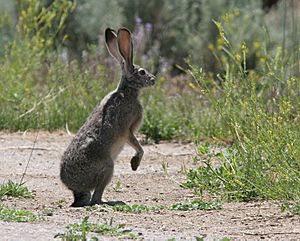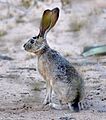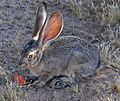Black-tailed jackrabbit facts for kids
Quick facts for kids Black-tailed jackrabbit |
|
|---|---|
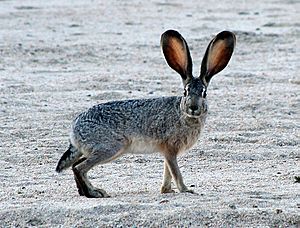 |
|
| Conservation status | |
| Scientific classification | |
| Genus: |
Lepus
|
| Species: |
californicus
|
| Subspecies | |
|
|
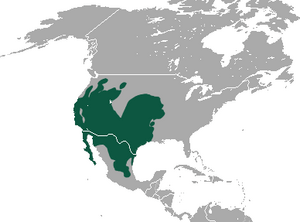 |
|
| Black-tailed jackrabbit range | |
The black-tailed jackrabbit (Lepus californicus), also known as the American desert hare, is a common hare found in the western United States and Mexico. These hares live in places from sea level up to about 10,000 ft (3,000 m) high.
Black-tailed jackrabbits are among the largest hares in North America. They can grow to about 2 ft (61 cm) long and weigh between 3 to 6 lb (1.4 to 2.7 kg). They like to live in areas with a mix of shrubs and grasslands.
Their breeding season changes depending on where they live. In warmer places, they might breed all year, but it usually peaks in spring. Baby jackrabbits are born with fur and open eyes. They can move around just minutes after birth, so their mothers don't stay with them much, except for feeding. A mother usually has about four babies at a time, but this can range from two to seven in warm areas.
Black-tailed jackrabbits do not move to different places or sleep through the winter. They use the same home area, which is about 0.4 to 1.2 mi2 (1–3 km2), all year long. They eat different kinds of plants, including shrubs, small trees, grasses, and forbs (flowering plants). Shrubs are a big part of their diet in fall and winter, while grasses and forbs are eaten more in spring and early summer.
These jackrabbits are an important food source for many animals. Birds of prey like eagles, hawks, and owls, and meat-eating mammals like coyotes, foxes, and wild cats, hunt them. Black-tailed jackrabbits can carry many tiny creatures on their bodies, such as fleas, ticks, lice, and mites. Because of this, hunters often avoid them.
Contents
What Do Black-Tailed Jackrabbits Look Like?
Like other jackrabbits, the black-tailed jackrabbit has very long ears. It also has strong, long back legs, which are typical for hares. It is the third-largest jackrabbit in North America. Only the antelope jackrabbit and the white-tailed jackrabbit are bigger.
The fur on its back is a mix of dark buff and black, which helps it blend in. Its belly and the inside of its legs are creamy white. The tips of its ears are black on the outside. The underside of its tail is gray or white, and a black stripe runs from its tail up its spine for a few inches. Female jackrabbits are usually larger than males, but they look very similar otherwise.
Where Do Black-Tailed Jackrabbits Live?
The black-tailed jackrabbit is the most widespread type of jackrabbit in North America. You can find them from central Washington all the way east to Missouri, and south into Baja California Sur and Zacatecas in Mexico.
These jackrabbits are even spreading further east in the Great Plains, taking over areas where white-tailed jackrabbits used to live. They have also been brought to southern Florida and along the coasts of Maryland, New Jersey, and Virginia.
What Kind of Places Do They Prefer?
Black-tailed jackrabbits can live in many different types of places, as long as there are various plants. They need a mix of grasses, flowers (forbs), and shrubs for food. They also need shrubs or small trees for cover and to hide.
They prefer open areas where plants are not too dense. You won't often find them in very thick forests. For example, they are common in open chaparral areas with scattered grasses, but not in dense chaparral. They also like clear-cut areas in forests but avoid thick, closed forests.
These jackrabbits do not move or hibernate in winter. They stay in the same area all year. During the day, they might move a few miles from shrubby cover to open areas to find food at night. Their home range can be about 0.4 to 1.2 mi2 (1–3 km2).
They need shrubs or small conifer trees for hiding, nesting, and staying warm or cool. Grassy areas are important for feeding at night. A mix of shrubs and grass, or shrubs spread out with other plants, gives them places to hide and opportunities to eat. Small shrubs don't offer enough cover. They usually don't use burrows, but sometimes they might use an abandoned one to escape or stay cool.
What Do Black-Tailed Jackrabbits Eat?
The black-tailed jackrabbit's diet includes shrubs, small trees, grasses, and forbs (flowering plants). They eat most of the important plants in their area throughout the year. The age and water content of plants might be more important than the plant species itself.
Generally, shrubs make up most of their diet in fall and winter. Grasses and forbs are eaten more in spring and early summer. This pattern can change depending on the weather. They eat green, leafy plants when they are growing, and use more shrubs during dry seasons. They browse on shrubs all year.
Jackrabbits get most of their body water from the plants they eat. They need plants to have at least five times more water than their dry weight to get enough water each day. So, when other plants are dry, black-tailed jackrabbits will switch to deep-rooted shrubs that hold more water.
They also eat seedlings of trees like Douglas fir, ponderosa pine, lodgepole pine, and western hemlock. They also eat oak seedlings and sprouts.
Food in Different Regions
In the Great Basin area, big sagebrush is a main food source all year. Other plants they eat include rabbitbrush, spiny hopsage, and black greasewood. Grasses make up about 14% of their diet, mostly in spring. Russian thistle is an important flowering plant they eat. They also like needle-and-thread grass and Indian ricegrass.
In warm desert areas, mesquite and creosotebush are key shrubs they browse. Other plants include broom snakeweed and Yucca plants. In some mesquite areas, their diet is about 47% shrubs, 22% grasses, and 31% forbs. They eat grasses like black grama and dropseed. Important forbs include leather croton and desert marigold. Cacti like Opuntia and saguaro are eaten all year, especially in dry seasons for their moisture.
Who Hunts Black-Tailed Jackrabbits?
The black-tailed jackrabbit is a very important food source for many birds of prey and meat-eating mammals. They are a main prey for hawks like the ferruginous hawk, Swainson's hawk, and red-tailed hawk. Other birds that eat them include the great horned owl, burrowing owl, golden eagle, and bald eagle. Golden eagle populations often grow when there are many jackrabbits.
Mammals that hunt them include coyotes, bobcats, lynx, domestic dogs, domestic cats, red foxes, gray foxes, American badgers, wolfs, and mountain lions. In many places, jackrabbits are the main food for coyotes. They are also important for bobcats and mountain lions.
Young jackrabbits can be eaten by rattlesnakes and garter snakes. Raccoons and striped skunks might also catch young ones.
Parasites and Diseases
Black-tailed jackrabbits can carry many tiny creatures on their bodies, called ectoparasites. These include fleas, ticks, lice, and mites. They also have endoparasites inside their bodies, like flukes, tapeworms, roundworms, and botfly larvae.
Diseases that affect black-tailed jackrabbits include tularemia, equine encephalitis, brucellosis, Q fever, and Rocky Mountain spotted fever. Ticks can spread tularemia, and infected ticks have been found on jackrabbits. Jackrabbits with tularemia often die very quickly.
Because of these diseases and parasites, many hunters do not pick up the jackrabbits they shoot. If they do, they should wear gloves and cook the meat very well to avoid getting sick. Most jackrabbit hunting is done to control their numbers or for sport.
![]() This article incorporates public domain material from the United States Department of Agriculture document "Lepus californicus".
This article incorporates public domain material from the United States Department of Agriculture document "Lepus californicus".
Images for kids
-
A young black-tailed jackrabbit eating a carrot in the California Mojave Desert.
See also
 In Spanish: Liebre de California para niños
In Spanish: Liebre de California para niños



